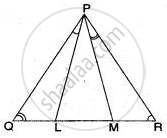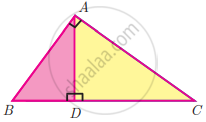Advertisements
Advertisements
प्रश्न
In ΔPQR, L and M are two points on the base QR, such that ∠LPQ = ∠QRP and ∠RPM = ∠RQP.
Prove that : (i) ΔPQL ∼ ΔRPM
(ii) QL. Rm = PL. PM
(iii) PQ2 = QR. QL.
उत्तर
(i) Consider
ΔPQL and ΔRPM
Since ∠PQL = ∠RPM
and ∠QPL = ∠RPM and
∠QPL = ∠PRM
By A. A. Criterion
ΔPQL ∼ ΔRPM
Hence Proved.
(ii) In ΔPQL ∼ ΔRPM
`"PQ"/"RP" = "OL"/"PM" = "PL"/"MR"`
then `"OL"/"PM" = "PL"/"MR"`
QL · MR = PL · PM.
Hence Proved.
(iii) In ΔPQR and ΔLQP
∠PQR = ∠LQP
PQ = PQ
Hence ΔPQR ∼ ΔLQP
`"QR"/"PQ" = "PQ"/"LQ"`
PQ2 = QR · QL.
Hence proved.
APPEARS IN
संबंधित प्रश्न
Using Basic proportionality theorem, prove that a line drawn through the mid-points of one side of a triangle parallel to another side bisects the third side. (Recall that you have proved it in Class IX).
State, true or false:
All isosceles triangles are similar.
In the given figure, ΔOAB ~ ΔOCD. If AB = 8cm, BO = 6.4cm, OC = 3.5cm and CD = 5cm, find (i) OA (ii) DO.
In the given figure, ABC is a triangle and PQ is a straight line meeting AB in P and AC in Q. If AP = 1cm, PB = 3cm, AQ = 1.5cm, QC = 4.5cm, prove that area of ΔAPQ is 116 of the area of ΔABC.
∆ABC and ∆DEF are equilateral triangles, A(∆ABC): A(∆DEF) = 1: 2. If AB = 4 then what is length of DE?

A line PQ is drawn parallel to the side BC of ΔABC which cuts side AB at P and side AC at Q. If AB = 9.0 cm, CA = 6.0 cm and AQ = 4.2 cm, find the length of AP.
In ΔABC, point D divides AB in the ratio 5:7, Find: `"AD"/"AB"`
In ΔABC, AB = 8cm, AC = 10cm and ∠B = 90°. P and Q are the points on the sides AB and AC respectively such that PQ = 3cm ad ∠PQA = 90. Find: The area of ΔAQP.
A model of a ship is made to a scale of 1:500. Find: The volume of the model when the volume of the ship is 1km3
In the adjacent figure ∠BAC = 90° and AD ⊥ BC then

